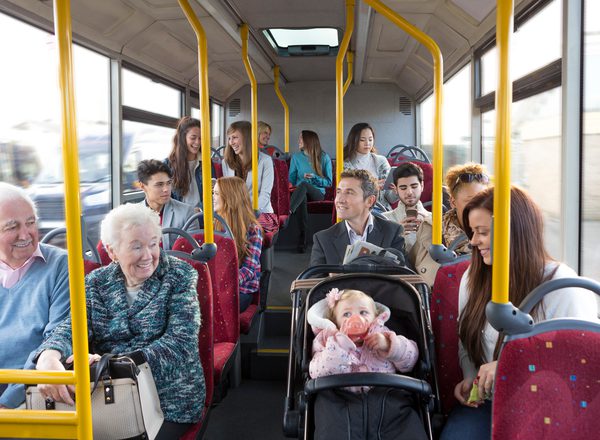
Everyday concerns: What people want from transport
Article
Transport has a key role to play in achieving the UK government's missions and improving lives.
New research from IPPR and More in Common reveals that the government has the public’s backing in delivering meaningful transport improvements if the approach and timing is right. Our polling and focus groups finds that transport may not be the issue people are thinking about at the ballot box, but it can provide the tangible proof that change is possible and lay the foundations for improved public trust in decision makers.
Transport matters to people's lives across Britain. The journeys that people make around their neighbourhoods and as part of daily routines can be the foundation for good health, stronger communities and thriving local economies. However, for too many people the available transport system limits access to opportunity, costs more than they can afford and feels unsafe.
Public confidence in the ability of government and local council to make people’s lives better is low, and investing in the right transport improvements could change that. From better maintained roads to more reliable buses and new pedestrian crossings, transport can provide a highly visible demonstration that governments are listening to people’s everyday concerns and acting on them. This can help rebuild trust in governments, but we shouldn’t get carried away with its potential to sway elections.
Fear of political backlash is overpriced in many politicians’ views on transport policies.
Despite its daily significance, transport is rarely at the front of people’s minds when they cast a vote in general or local elections. Other issues are more electorally salient, including household bills and access to healthcare. Many voters would find it hard to name a transport policy in recent manifestos, let alone describe the differences between political parties. This low salience provides the government with the political space to do what is necessary to make transport work for people.
Fear of political backlash is overpriced in many politicians’ views on transport policies. Recent examples of transport interventions that have been framed as divisive by some, but ultimately have minimal political impact or long-term effect on public opinion, include the following.
- London’s ultra low emission zone (ULEZ) and low traffic neighbourhoods. There is no evidence that either have had a negative impact on the mayoral or council elections.
- Barcelona’s ‘superblocks.’ There are signs that these ambitious road space reallocation projects may even have boosted local support for the incumbent party.
- Congestion charging in Stockholm, London and, most recently, New York. The rise in public support after the introduction of targeted road pricing schemes is widely known as the ‘Goodwin curve’.
the government have leeway to make bold, evidence-based decisions on transport but it would be wise to make them with space for the dust to settle
These examples align well with the electoral boost described by decision makers who have delivered transformative transport policies. Short of making a calamitous decision, such as the Beeching cuts, the government has leeway to make bold, evidence-based decisions on transport, but it would be wise to make them with space for the dust to settle before an electoral test (for example, by early 2028 for a general election due in 2029).
In public attitudes research undertaken with More in Common, and with valuable input from Climate Outreach and the Centre for Climate Change and Social Transformations (CAST), we explored these themes and the public’s hopes for the future of transport. The findings from a national survey of adults in Great Britain are available to download from this page and the conclusions from five focus groups covering Cornwall, Nottingham, Oxford, Sheffield and Wolverhampton are available on More in Common’s website. The below describes some of the key findings and their policy implications, showing that:
- a people-focussed approach to transport is needed to deliver the changes the public want and will notice
- there is significant public support for local transport improvements and making streets work better for everyone
- reducing the harms transport inflicts on children must be a high priority.
People's hopes for the future of transport
The public are clear what better transport looks like. No matter how you vote, where you live or currently get around there is a clear desire for more public transport options and for these to be affordable, accessible and better integrated. City and town centres that prioritise pedestrians, neighbourhood streets with space for children to play and supporting more active journeys to school are all popular.
Although there is significant common ground between groups, there are also notable differences in priorities for low earners versus those on higher incomes. Higher earners, who travel more and further, are the least likely to say that transport improvements wouldn’t make a difference in their lives (just 6 per cent felt this) and the most likely to feel that investment in international transport would make the most positive difference (18 per cent). Conversely, those on lower incomes are the most likely to see local transport investments as the most likely to make a difference in their lives (38 per cent, with just 2 per cent naming international transport improvement).
This same dynamic plays out when contrasting investment in public transport with spending on new roads (see figure 18 in full briefing). All income groups feel that making public transport more affordable and available should be a priority and would make a difference in their lives. Only higher income groups show net agreement for new roads (+34 per cent) being important to them and their family, with other groups being at best neutral and lower earners strongly oppositional (net score of -19 per cent). As well as being lower value for money, this suggests adding road capacity is generally more divisive than improving public transport.
Prevalence of life-limiting transport challenges
Over four in 10 (44 per cent) consider transport difficulties to be limiting everyday life with one in seven (14 per cent) strongly feeling this. This question serves as an indicator for self-reported social exclusion, defined by Transport for the North as “being unable to access opportunities, key services, and community life as much as needed, and facing major obstacles in everyday life through the wider impacts of having to travel to access key destinations”.
Many Britons are also exposed to the risk factors for transport-related barriers to social inclusion. The cost of a private vehicle making it difficult to afford other essentials is the most common issue with almost two thirds, 63 per cent, expressing at least medium agreement with this statement and around one-fifth, 18 per cent, stating high agreement. The three most widespread and severely felt transport challenges relate to travel disruptions, not being able to get to important places (eg due to gaps in the public transport network) and transport costs.
Safety is a key concern across all transport modes
Improving physical and social safety while travelling is vital, particularly for those currently marginalised within transport decision making. Not enough people feel safe getting from their door to destination, and back again, particularly when the journey involves travelling at night. Women, young people, disabled people and black and minority ethnic communities all show higher than average levels of concerns about discrimination, harassment and violence on public transport.
The government has public backing to deliver a road safety strategy that targets zero road deaths and serious injuries (56 per cent support this, with just 13 per cent opposed). This support is particularly high in London (61 per cent, where a ‘Vision Zero’ target is already in place for ‘before 2041’) and amongst progressive voters (with support from seven in 10, 69 per cent, of those who voted Labour, Liberal Democrat or Green at the last general election).
Recommendations
These survey findings, combined with the views of our focus group participants, provide insights to inform both national and local transport policy decisions, including the proposed integrated national transport strategy. Our key recommendations for national transport decision makers are:
- Introducing an England-wide public engagement strategy for sustainable travel, as is now in place in the Republic of Ireland. The Department for Transport should convene citizens’ juries on issues with a significant moral dimension that have implications for people’s daily lives (including the approach taken to reducing road danger or delivering changes to motoring taxation, as recommended below). In a low trust environment the government must communicate its goals and progress clearly, choosing measures that matter to the public will be central to this and should include: lives saved and serious injuries avoided, reliability and cost of train services, availability of frequent bus services, road conditions, and accessibility of public transport.
- Backing local leaders in introducing interventions that nudge people towards more sustainable and less dangerous travel options as quickly and fairly as practical. School streets, pedestrianised town centres, targeting SUVs for higher parking charges, clean air zones, lower speed limits in residential areas and more severe penalties for breaking them all receive public support, despite placing new limits or charges on car use. If the government still has concerns about the electoral impact then a target to have new measures in place across England’s urban areas by early 2028, well before a general election, would mitigate this. This local focus must be linked to a UK-wide discussion on the future of fuel duty and motoring taxation.
- Adopting the safe system and setting a target to achieve zero road deaths and serious injuries. The UK government should follow the leadership shown in parts of the UK in setting a vision zero target, with a clear immediate focus on creating safer streets for children to move around and play. This should sit as part of an holistic public health strategy for transport that addresses the sector’s role in achieving the government’s goal of shifting the UK’s approach to health towards prevention – road danger reduction, reducing air pollution and supporting physical activity all require similar policy responses, particularly in urban areas.
Related items

A people-focussed future for transport in England
Our findings from three roundtables on the impact of transport in people’s lives and the priorities for change.
The sixth carbon budget: The first plan without consensus
For decades, UK climate action was cross-party, and consensus meant policy looked different to politically competitive issues like tax.
Skills passports: An essential part of a fair transition
This month, government will publish its Clean Energy Workforce Strategy. This plan covers two aims. First, filling the growing demand for skills in clean energy industries is essential to keep on track to reach the government’s clean power…